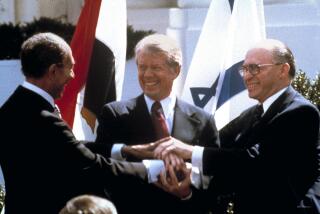Cambodia: Peace at Last?
- Share via
Peace appears to be within reach in beleaguered Cambodia for the first time in more than a decade. China and Vietnam finally have adopted a formula for extricating themselves: China will phase out its military aid to the Cambodian guerrillas who have fought the powerful Vietnamese army to a stand-still, and, by September, Vietnam will withdraw the 100,000 troops that have occupied Cambodia since late 1978. Their agreement, described as “watertight” by Australia’s foreign minister, does not solve all of Cambodia’s problems, but it does remove the logistical and psychological support on which the warring Cambodian factions have relied.
The next step, of course, is formidable. Former Cambodian monarch Norodom Sihanouk is regarded by the United States, China and the Cambodian resistance as the natural leader of a unified Cambodia, if only during a transition period that would end with free elections. But the terms that Sihanouk has laid down so far have been unacceptable to the current Cambodian government: Because he and the guerrillas whom he nominally leads regard that government as illegitimate, a Vietnamese puppet, they have demanded that it dissolve itself, join a four-party coalition regime and accept the murderous Khmer Rouge as one of its partners. The Phnom Penh government, led by Premier Hun Sen, is understandably reluctant to vote itself out of power and quite justified in regarding the Khmer Rouge as a possible threat. The Khmer Rouge, who murdered more than a million Cambodians between 1975 and the 1978 Vietnamese invasion, are capable of exacting revenge on that scale once again.
To win worldwide acceptance, the Khmer Rouge in recent months have put on a more civilized face; their chief spokesman, Khieu Samphan, has undertaken a diplomatic offensive throughout Asia, promised that the Khmer Rouge would never attempt to dominate a new Cambodian government and urged an international peacekeeping force for Cambodia after Vietnamese forces withdraw. The Chinese announcement that it will supply no further arms to the resistance is reassuring, but the Khmer Rouge, over the years the primary recipient of Chinese largess, remain a danger to their coalition partners, to Cambodia’s neighbors and to ordinary Cambodians. The Khmer Rouge still command by far the largest guerrilla army, estimated at 40,000 men, and are thought to have stockpiled huge quantities of Chinese-made weapons and ammunition in the Cambodian jungle. If the Khmer Rouge want a role in a post-occupation Cambodia, they must agree to disarm, perhaps in exchange for the dissolution of the Hun Sen government.
It is unclear whether China, the Khmer Rouge’s long-time patron, will push them to lay down their arms, but China is so eager to have the Vietnamese out of Cambodia that it may ignore its usual scruples about pressuring fraternal Communist parties. And a defanged Khmer Rouge would please not only the other potential partners in a Cambodian coalition but also the other states of Southeast Asia, for which the Khmer Rouge have made endless trouble. It is no coincidence that the diplomatic groundwork for the next round of Cambodian negotiations, to be held in Jakarta on Feb. 19, has been laid by Thailand. After sheltering the resistance and hundreds of thousands of refugees in camps along its Cambodian border, Thailand is weary of the Cambodian conflict. All the Cambodian parties, as well as the members of the Assn. of Southeast Asian Nations, now have agreed to appear on schedule in Jakarta--another sign that Cambodia’s future may hold something other than death and destruction.
More to Read
Sign up for Essential California
The most important California stories and recommendations in your inbox every morning.
You may occasionally receive promotional content from the Los Angeles Times.













